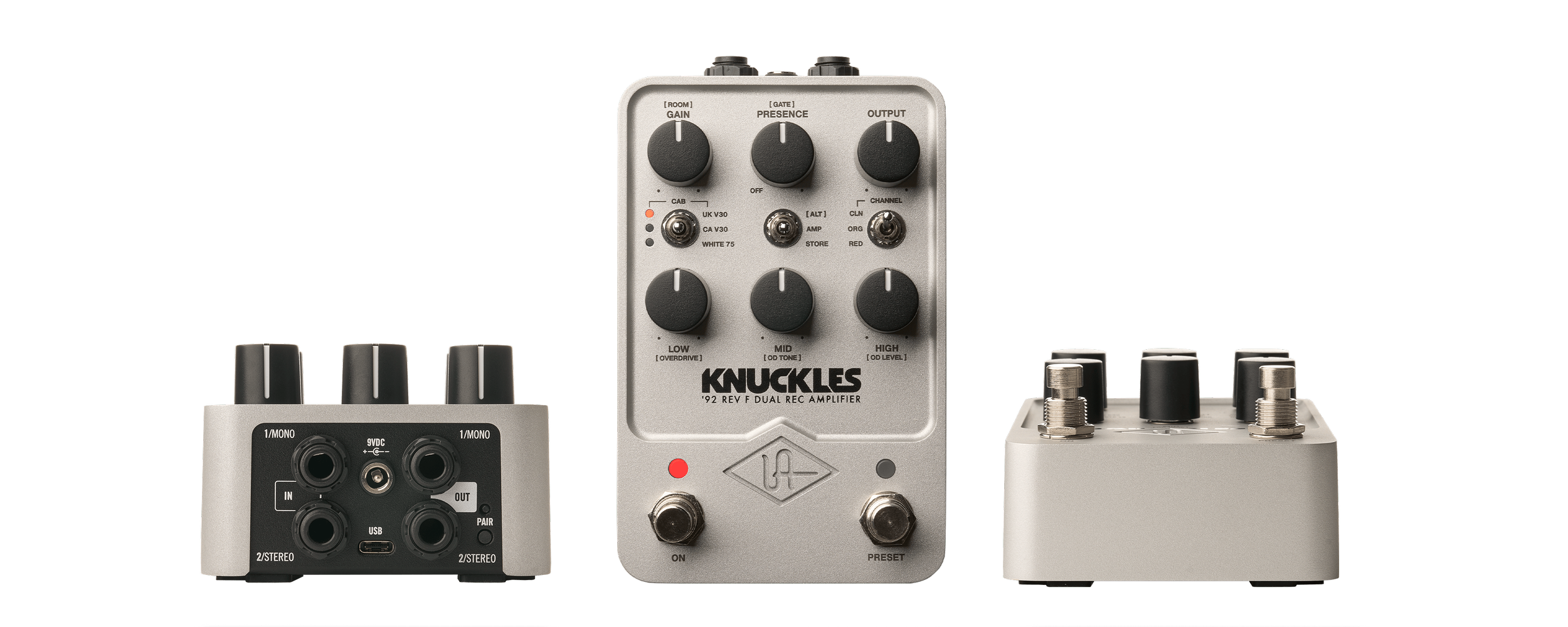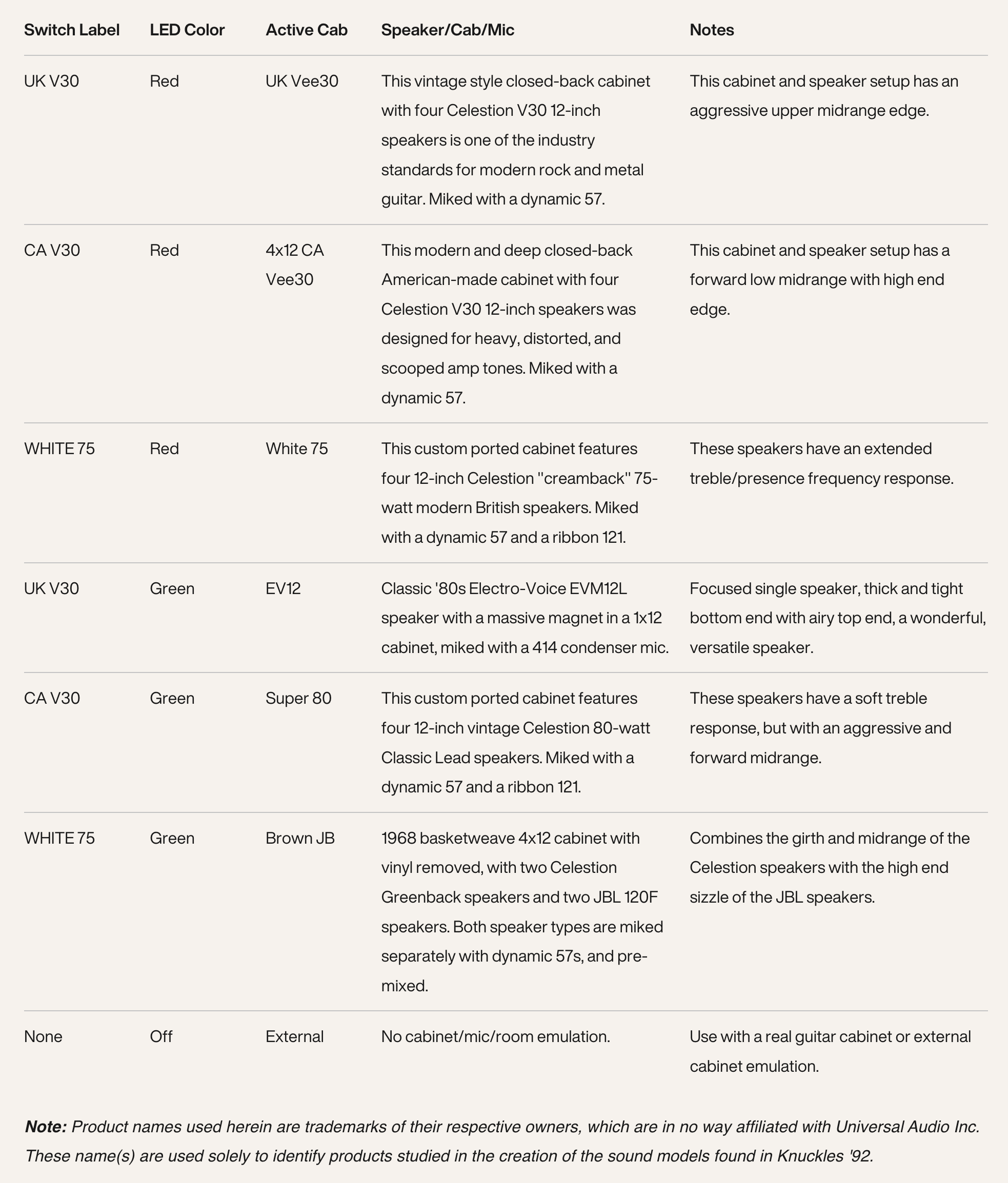Review : Universal Audio Knuckles ‘92 Rev F Dual Rectifier Amp - The Dual Rectifier That’s Easy to Carry
Hey folks. Back with another pedal this time, and this time it’s the Universal Audio Knuckles ‘92 which as you may have gathered is the UA amp pedal that models a Mesa Dual Rectifier amplifier, cabinet and miking set up.
While Mesa’s Rectifier amps are known best for their driven sounds and their use in hard rock and metal, unless you’ve played on, they are massively capable amplifiers covering from a nice clean to that Mesa Rectifier sound. They are also known for their channel flexibility offering three channels, each with its own unique sound in a single box, most commonly found as a head and at least one 4x12 flat front cabinet. There is also a Triple Rectifier model, which is similarly awesome. However since Gibson bought Mesa, nothing has happened with the line other than having Mesa build the overpriced and thus far unloved Gibson Falcon amplifiers, as well as an update to the Mesa Boogie Mark V bringing us the Mark VII.
One of the usage challenges of the real Dual (and Triple) Rectifiers, is that they are extremely loud by design. Unless you are playing in a giant venue, you won’t be able to unleash the power, and if you show up with one, or even the more recent Mini Dual Rectifier to a smaller venue, expect at minimum the hairy eyeball or at most a vehement “No!”
But that sound….
Mesa does a series of attenuation devices called the Cab Clone family that are really very good, but they don’t take away the other challenges of size and weight. And that is where the Knuckles ‘92 comes in.
The History of the Dual Rectifier
The Mesa Dual Rectifier amplifier, was introduced in 1989 by Mesa Engineering, and according to afficianados is a landmark product in the evolution of modern guitar amplification. Designed by Randall Smith, the Dual Rectifier quickly became a defining tool for high-gain tones, influencing the sound of rock, metal, and other heavy genres. That Randall Smith is widely regarded as an amplifier design genius is well known, and after Gibson “released” him, most Mesa lovers fear that the innovation and brilliance of the line is over. Gibson has never done innovation well and they trade on the value of the name rather than the quality or innovation of the product.
Origins
Mesa Engineering was already well-established for its high-quality amplifiers, including the Mark series. The Dual Rectifier was a departure, offering players more aggressive tones and features tailored to the evolving demands of hard rock and metal musicians in the late 1980s and early 1990s.
The name “Dual Rectifier” comes from the amplifier’s switchable rectification system. Players could choose between silicon diodes for a tighter, more aggressive sound or a tube rectifier for a warmer, spongier response. This versatility allowed the amp to cater to a wide range of styles, from classic rock to modern metal.
Features and Innovations
The Dual Rectifier introduced several notable features:
• Multi-Channel Design: With separate channels for clean, crunch, and high-gain tones, it allowed players to switch seamlessly between different sounds.
• High Gain Capabilities: The amp was among the first to provide heavily saturated distortion while maintaining clarity, which became a hallmark of its sound.
• Power and Headroom: Available in various wattages, the Dual Rectifier provided loud, punchy tones suitable for both studio recording and live performance.
Known Artists
The amplifier gained widespread popularity in the early 1990s as bands like Metallica, Alice in Chains, and Korn embraced its sound. The Dual Rectifier became synonymous with the heavy, cutting guitar tones that defined the grunge, nu-metal, and modern rock movements.
The Knuckles ‘92 Rev F Dual Rectifier Amp
Is this really an amp? For most current intents, I say that it is. I run mine mostly direct into the recording interface because I prefer the amp sound on the input rather than adding it later. I also plug it directly to an FRFR speaker system when I want the sound and the feel of a real amplifier. Does it push air the way a real Dual Rec and cab do? Of course not, but then, the local constabulary is also not banging on my door with complaints about the volume from the kiddies across the street in the school parking lot playing their whatever the hell that noise is at past irritating volume levels.
The Cabinets
The Knuckles ‘92 Rev F Dual Rectifier Amp offers three cabinet sets native and you get three more on registration. You will see below the cabinet options included with the pedal.
The Sounds
Let me start with the word AWESOME! You know that shiver that you get up and down your spine, all too rarely for me? My first play was with a PRS S2 Standard 24 that I have for review, into the Knuckles ‘92 and out direct to a Headrush FRFR. Once I got the volume to a neighbour friendly level, I spent over an hour just making glorious noises. I cannot bring my foot up fast enough to kick myself in the butt for not buying that Gold Finish Triple Rectifier that was on sale at The Arts Music Store for months. Sure space and volume would have been a problem. but damn, that sound is so beautiful. And I will tell you up front that I have a LOT of different Dual Rectifier models and profiles and NONE sound as good, or have the tonal versatility of the Knuckles ‘92. It is, to my mind, a real amp.
To make this review more useful I asked my friend Cody Shaw who is a dedicated Dual Rectifier user for his thoughts. Cody thought it would be fun to bring his Dual Rectifier down and then play it back to back with the Knuckles, so he did. The first audio section is our conversation about the two, recorded AFTER the playing. The second recording is the actual back to back playing. The first two are recorded with the Dual Rectifier and the Knuckles set to the Red channel and the second pair has the Dual Rectifier and the Knuckles set to the Orange channel. Post a comment if you want to know for sure which is which.
Wrapping Up
In my perspective, the Universal Audio Knuckles ‘92 Rev F Dual Rectifier Amplifier is the closest that I have heard to something that sounds like a real Mesa Boogie Dual Rectifier. Are there differences? Yes, but they are very subtle, and if you need the sound of a Dual Rectifier without the cost, the space and the weight, this is the one device that does it. If you want one, contact The Arts Music Store, and they can order one for you, or check in with your local high quality guitar shop.
If you like what I do here for you, please become a supporter on Patreon. Your monthly contribution makes an enormous difference and helps me keep things going. To become a Patreon Patron, just click the link or the button below. Thanks for your support of my work. I’m Ross Chevalier and I look forward to sharing with you again soon.


